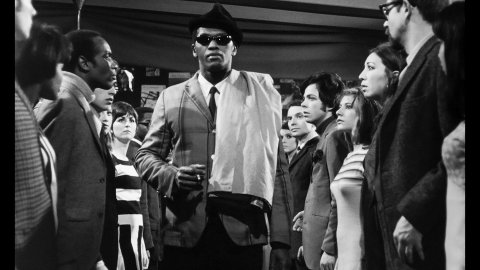
French New Wave influences in The Story of a Three-Day Pass
Posted on Fri 10 Sept 2021
Cinema Rediscovered 2021 Film Critics Workshop participant Yasmin Omar explores the French New Wave influences in The Story of a Three-Day Pass (1967).
Racism prevented the African American director Melvin Van Peebles from mounting a feature film in his home country in the 1950s. Upon presenting his promising 1957 shorts to Hollywood executives in the hope of securing work as a filmmaker, Van Peebles was dismissed and offered a position as an elevator operator. Determined, the Chicago-born artist followed in the footsteps of his creatively stymied Black compatriots (among them Josephine Baker, James Baldwin, and Miles Davis) and relocated to Paris, where he was later able to adapt his 1967 novel La Permission for the big screen. Van Peebles was rejected by Hollywood and, in turn, he rejected its conventional filmmaking practices in his loose, experimental feature debut, The Story of a Three-Day Pass.
The film – which follows the Black American soldier Turner (Harry Baird) and his budding relationship with a white French woman, Miriam (Nicole Berger), during his weekend furlough from the army – is replete with winking references to La Nouvelle Vague (French New Wave). It includes a synchronised dance sequence performed by three Black men at a bar, reminiscent of the titular outcasts’ similarly staged café choreography in Jean-Luc Godard’s Bande à Part (Band of Outsiders, 1964); as well as freewheeling, handheld shots of the lovers zooming around the French capital by car that evokes Jean-Paul Belmondo and Jean Seberg’s jaunts in À bout de souffle (Breathless, 1960). Even the presence of Berger in The Story of a Three-Day Pass – as she appeared in films by Godard and other key figures from La Nouvelle Vague such as François Truffaut (director, Tirez sur le pianiste, 1960) and Éric Rohmer (writer, Charlotte et Véronique, ou Tous les garçons s’appellent Patrick, 1959, directed by Godard) – aligns Van Peebles’ work with that of his predecessors.
On a formal level, Van Peebles uses the disorienting distanciation techniques that were a defining element of La Nouvelle Vague, including freeze frames, split screens, and direct-to-camera address. A memorable sequence that feels indebted to the filmmakers comes during the soldier’s thwarted meet-cute in a Paris bar. His soul exits his body when he spies a laughing woman across the room, his superimposed image stepping towards her as a ghostly apparition. Sultry piano plays on the soundtrack as dancers part in slow motion, allowing Turner to glide towards her. Van Peebles cuts to a fantasy sequence of the two of them in a tree-lined avenue, running towards each other with arms outstretched. The director then bathetically undermines what could have been a love-at-first-sight moment by jump-cutting back to the bar and reality, where Turner has not moved from the counter (the woman later spurns his advances in their actual interaction). This imagined encounter mocks the artifice of traditional romance narratives – where would-be lovers fall for each other instantly – and creates a comedic tone that emphasises the ridiculousness of this storytelling conceit.
Although American, Van Peebles employs the spirit of La Nouvelle Vague in The Story of a Three-Day Pass through his references to its landmark films, adoption of its cinematic language, and questioning attitude towards the tropes of classical Hollywood cinema.
The Story of a Three-Day Pass (1967) is touring UK cinemas until the end of October following the UK Premiere of its 4K restoration at Cinema Rediscovered 2021 in July with tour details available here.
Yasmin Omar
Yasmin Omar is the entertainment writer at Harper's Bazaar, where she writes actor and filmmaker profiles, cover stories and think pieces for print and digital. A Rotten Tomatoes-approved film critic, she started her online review column 'Why You Should Watch' for Bazaar in 2019 and regularly covers all manner of movies, from foreign-language features to American indies and superhero blockbusters. Yasmin annually reports from key film festivals – she waited 4.5 hours to catch the first screening of Once Upon a Time in Hollywood at Cannes and maintains every second was worth it – as well as red-carpet events. Her writing has been published in the Financial Times, the Guardian, Digital Spy, Town & Country, Girls on Tops (Read Me) and Film Cred.
Yasmin’s Twitter and Letterboxd handles are @yasmin_omar6 and Instagram is @yasmin242.
